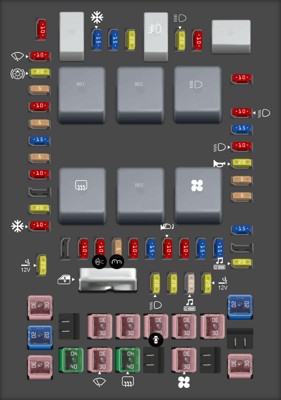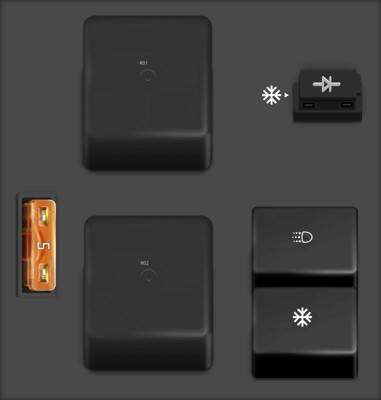Understanding the fuse box system in your 2004 Ford F-150 is crucial for maintaining its electrical health, including the functionality of your OBD2 port. Fuses protect your truck’s electrical circuits from overloads, and when one blows, it can affect various components, potentially including your On-Board Diagnostics system, accessible through the OBD2 port. This guide will help you locate the fuse boxes and identify fuses that are relevant to the OBD2 system in your 2004 Ford F-150.
Decoding the 2004 Ford F-150 Fuse Box Layouts
Your 2004 Ford F-150 is equipped with three distinct fuse boxes, each serving different electrical circuits. Knowing their locations and layouts is the first step to diagnosing and resolving electrical issues, especially those related to your OBD2 port.
Passenger Compartment Fuse Panel (Power Distribution Box)
This fuse box is likely the one you’ll access most frequently. It’s located inside the cabin and is responsible for many of the interior and some exterior functions of your F-150.
Here’s a breakdown of some key fuses within the passenger compartment fuse panel that might be relevant to your OBD2 system or general vehicle diagnostics:
| Fuse Number | Amperage | Circuit Protected |
|---|---|---|
| 41 | 20A | Cigar lighter, Diagnostic connector power |
| 5 | 5A | Keep alive memory for Powertrain Control Module (PCM) and climate control module |
| 16 | 10A | ABS module (Run/Start power) |
| 19 | 10A | Restraints (Air bag module) |
| 20, 29 | 15A | PCM 4×4 power |
| 34 | 20A | Fuel injectors and PCM power |



Fuse #41, rated at 20A, is explicitly listed as providing power to the diagnostic connector, which is your OBD2 port. If you are experiencing issues with your OBD2 scanner not powering up or connecting to your 2004 Ford F-150, this fuse should be one of the first things you check.
Auxiliary Relay Box (with DRL)
Some 2004 Ford F-150 models are equipped with Daytime Running Lights (DRL). If your truck has DRL, it will have this auxiliary relay box.
While this fuse box is labeled as “Auxiliary Relay Box (with DRL)”, the provided diagram and fuse list do not show fuses directly related to the OBD2 port. It mainly contains relays and a few fuses associated with lighting and air conditioning.
Auxiliary Relay Box (without DRL)
For 2004 Ford F-150 models without Daytime Running Lights, a slightly different auxiliary relay box is used.
Similar to the “with DRL” version, this auxiliary relay box does not contain fuses that are directly identified as being for the OBD2 port based on the provided information.
Finding the OBD2 Port Fuse and Troubleshooting
While there isn’t a fuse labeled solely as “OBD2 fuse” in the diagrams, Fuse #41 (20A) in the Passenger Compartment Fuse Panel, described as “Diagnostic connector power,” is the fuse you need to inspect if you suspect a fuse issue with your OBD2 port.
Troubleshooting Steps:
- Locate the Passenger Compartment Fuse Box: Refer to your owner’s manual for the exact location, but it’s typically under the dashboard on the driver’s side.
- Identify Fuse #41: Use the diagram provided or the fuse box cover diagram to locate fuse position 41.
- Inspect the Fuse: Visually check the fuse. A blown fuse will usually have a broken wire inside or appear blackened.
- Replace if Necessary: If the fuse is blown, replace it with a new 20A MINI fuse. Important: Always use the correct amperage rating. Using a higher amperage fuse can damage your vehicle’s electrical system.
- Test Your OBD2 Port: After replacing the fuse, try connecting your OBD2 scanner again to see if it now powers up and communicates with your vehicle’s computer.
If replacing Fuse #41 does not resolve the issue, there might be other problems such as wiring issues, a faulty OBD2 port, or a problem with your scan tool itself. In such cases, it’s recommended to consult a qualified mechanic or automotive electrician for further diagnosis and repair.
By understanding the fuse box layout and identifying the relevant fuses, especially Fuse #41, you can effectively troubleshoot potential OBD2 port issues in your 2004 Ford F-150 and ensure you can access your vehicle’s diagnostic information when needed.
